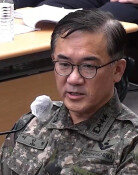John Kerry at Hiroshima peace park
John Kerry at Hiroshima peace park
Posted April. 12, 2016 07:16,
Updated April. 12, 2016 07:19
"Little Boy" was the codename for the historic 3-meter-long, 4.36 ton nuclear bomb dropped on the Japanese city of Hiroshima on Aug. 6, 1945 by the Boeing B-29 Superfortress Enola Gay (named after the pilot Colonel Paul W. Tibbets). It exploded with an energy of 13 kilotons of TNT at a height of 580 meters, turning the whole city into ashes. As many as 70,000 to 80,000 were killed immediately and another 70,000 were injured. Nearly 69 percent of all the buildings were destroyed. If Japan had surrendered right away, the second bomb “Fat Man” would have not blasted in Nagasaki three days later.
The Hiroshima Prefectural Industrial Promotion Hall, located 160 meters away from the "ground zero" was the only building that survived. The remaining skeleton of the building was designated as the Hiroshima Peace Memorial, symbolizing anti-nuclear, peace movement, and became one of UNESCO World Heritages in 1996 despite opposition from the U.S. and China. A peace memorial park was created along the Motoyasu River before the building to remind the consequences of nuclear bombing. On one side lay the monuments of 20,000 Korean victims, giving us a historical burden to share.
U.S. Secretary of State John Kerry visited the memorial park and laid flowers, during his travel to Japan for attending the G7 Foreign Ministers Meeting. Washington has always taken a stance that the bombings were inevitable to ending the war, thus no apology is necessary. Kerry’s comments emphasizing that the trip is not about the past but about the present and the future, represents this stance well. U.S. President Barack Obama is considering following the footsteps of Kerry on his visit to Japan next month, but it would depend largely on public opinion.
It would be unacceptable, however, as Japan tries to settle on the fact that it is the only victim in history of nuclear blast while denying its past wrongdoings. It would be more meaningful if it makes efforts to reinforce global cooperation to prevent nuclear proliferation by reminding the world of the disastrous history. A nuclear bomb with augmented explosive power would lead to a misery hundred times worse than what happened to Hiroshima.
한기흥기자 eligius@donga.com



![[단독]현직 검사, ‘검찰청 폐지’ 첫 헌법소원…“수사권 박탈 위헌”](https://dimg.donga.com/c/138/175/90/1/wps/NEWS/IMAGE/2025/12/30/133061316.1.jpg)



